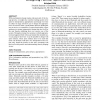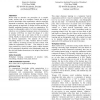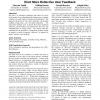79
Voted
NORDICHI
2006
ACM
15 years 6 months ago
2006
ACM
Users should be involved in the development of information technology (IT) artifacts. However, this is challenging, especially in product development context, in which Human Compu...
93
Voted
NORDICHI
2006
ACM
15 years 6 months ago
2006
ACM
In this paper we discuss why access to mathematical graphs is problematic for visually impaired people. By a review of graph understanding theory and interviews with visually impa...
97
Voted
NORDICHI
2006
ACM
15 years 6 months ago
2006
ACM
This paper describes a series of user-centred design sessions conducted with children of varying ages to explore near-future applications of sensor-based technologies. We explain ...
65
Voted
NORDICHI
2006
ACM
15 years 6 months ago
2006
ACM
71
Voted
NORDICHI
2006
ACM
15 years 6 months ago
2006
ACM
Downstream utility is a critical success factor for usability evaluation methods, in terms of the extent to which they can deliver value. In this paper we argue that field methods...
68
Voted
NORDICHI
2006
ACM
15 years 6 months ago
2006
ACM
How do individual HCI-practitioners evaluate their own work practice? And how would they like to evaluate it? Answers to these questions will give new knowledge on the state-of-th...
84
Voted
NORDICHI
2006
ACM
15 years 6 months ago
2006
ACM
While participatory design makes end-users part of the design process, we might also want the resulting system to be open for interpretation, appropriation and change over time to...
86
Voted
NORDICHI
2006
ACM
15 years 6 months ago
2006
ACM
The evaluation of e-learning applications deserves special attention and evaluators need effective methodologies and appropriate guidelines to perform their task. We have proposed...
83
Voted
NORDICHI
2006
ACM
15 years 6 months ago
2006
ACM
Stories help us structure our perception of a complex reality. Stories told in a workplace context also help to preserve knowledge of the organization, which is especially importa...
85
Voted
NORDICHI
2006
ACM
15 years 6 months ago
2006
ACM
Our aim is to introduce techniques that allow for active involvement of users throughout the design process, starting with the very early stages of ideation and exploration. The a...



